Week 30 - Aquatic Organisms are Affected by Many Factors
| Site: | MoodleHUB.ca 🍁 |
| Course: | Science 8 LearnNet |
| Book: | Week 30 - Aquatic Organisms are Affected by Many Factors |
| Printed by: | Guest user |
| Date: | Monday, 17 November 2025, 5:54 PM |
Description
Week 30 - Aquatic Organisms are Affected by Many Factors
Lesson 8
To this point in the unit, you have studied the distribution and importance of water on Earth. You have also been introduced to freshwater and saltwater ecosystems. In this lesson, you will learn more about the plants and animals that are adapted to survive in the freshwater and saltwater ecosystems. You will begin with an introduction to structural and behavioral adaptations of organisms. All organisms have certain adaptations that allow them to survive in some areas and not in others. For example, a whale stranded in shallow water or on a beach does not survive very long even though whales are air-breathing animals. An adaptation is any structure or behavior that helps an organism survive in its environment. Adaptations develop in a population over a long period of time.
Structural Adaptations
| Some organisms have body structures that help them survive in their habitat or environment. The blubber in seals and whales helps protect these mammals from the cold temperatures in northern ocean waters. | 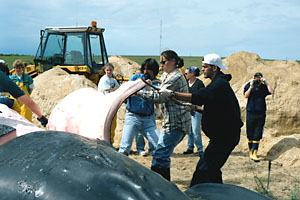 |
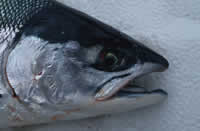 |
Fish and many other aquatic animals use gills to extract oxygen from the water. |
| Many aquatic plants and algae have devices that allow them to float on the surface of water to make sure they get the light they need for photosynthesis. | 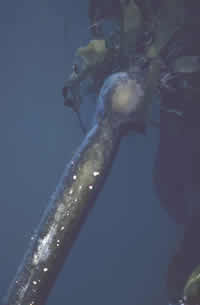 Bull kelp with hollow ball that helps it to float on the surface. |
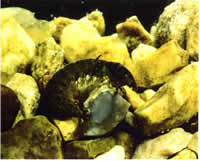 Caddisfly larvae in nest |
Insect larvae that live in fast moving streams are usually flat or form homes of rocks and twigs to prevent being washed away. |
Behavioral Adaptations
Some organisms display behavioral adaptations that help them survive in their habitat.
| For example, salmon spawn in freshwater streams and then migrate to the ocean to feed and grow. |  |
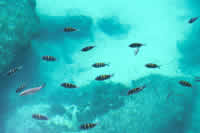 |
Many types of fish gather together in large numbers to protect them from predators. |
| Intertidal organisms such as sea stars crawl under rocks and in crevices to keep out of the sun when the tide goes out. | 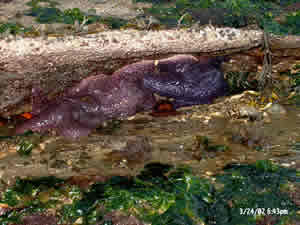 |
The pictures below show that depth is how the zones are selected. There are 4 titles for the zones used in the text. These ate the titles you need to remember.
Intertidal Zone
Estuary
Continental Shelf Zone
Oceanic Zone
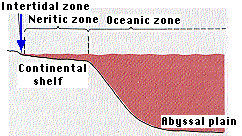

Exercise 3.1A: Adaptations
1. For more information on saltwater ecosystems, go to the Nature Web Marine Communities web site. Here you will find information on the different marine ecosystems and the plants and animals that live in this area. 2. For more information on freshwater ecosystems, go to the Nature Web Freshwater Communities web site. Here you will find information on the different freshwater ecosystems and the plants and animals that live in this area.
Lesson 9
Read pages 381 - 384
|
A population is the individual organisms of the same species living in the same place and at the same time
|
The leeches living in a prairie slough in 2002 forms a population. Members of populations of organisms compete with each other for food, space, and mates. The resources of the environment and how the organisms use these resources determine how large a population can be.
Populations
Most populations do not live in isolation. They live and interact with populations of other organisms.
|
Groups of populations that interact with each other in a given area form a community.
|
Populations of organisms in a community depend on each other for food and shelter and for other needs.
Within every habitat, communities of organisms exist in a close relationship to each other. Communities may be as small prairie pothole, as large as Lake Athabasca, or as complex as the intertidal zone along the rocky shore of one of British Columbia's Gulf Islands.
 |
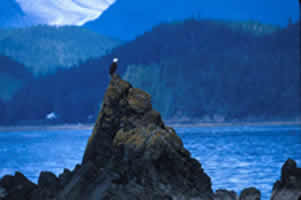 |
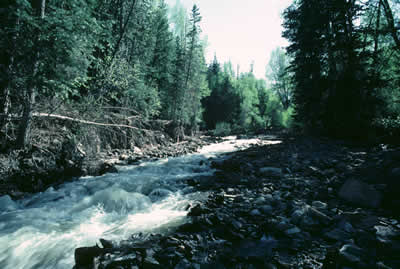 |
|
 |
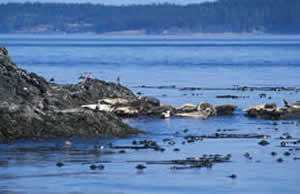 |
The relationships among species form a complex web. Some organisms produce food and others serve as prey. Some communities, such as the submerged vegetation along the shore of a marsh or slough provide both food and cover for the other organisms.
Change
Change is characteristic of ecological systems.
|
Living factors can cause change in communities
|
non-living factors can cause change in populations
|
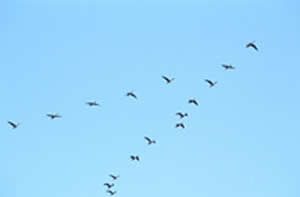 |
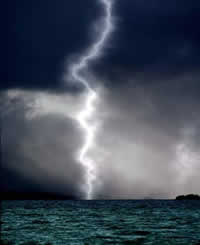 |
|
Germination of plant seeds, birth of animals, growth, movement and migration of animals affect the population size and composition of each community.
|
The temperature of the water, the amount of dissolved oxygen, and many other non-living factors can also have a dramatic impact on the population of plants and animals.
|
Some variations, such as seasonal changes, follow a predictable pattern. These are just a few examples of seasonal variations in the population size.
|
Birds
|
Salmon
|
Mosquito
|
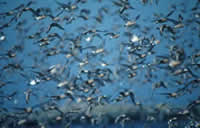 Large population of geese Large population of geese |
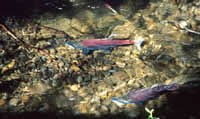 Young salmon in a river bed. Young salmon in a river bed. |
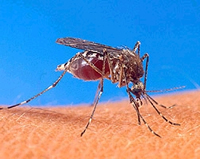 |
|
Every year, many species of birds migrate to the lakes and rivers of northern Alberta to breed. The population of these birds increases in the spring and decreases in the fall.
|
In coastal waters, salmon swim upstream to spawn. The population of salmon in the rivers is high at that time of year. However, after the old salmon die and the young salmon swim to the ocean, the population of salmon is dramatically lower
|
In the spring, mosquito eggs that have survived over the winter hatch and the larval stage of the mosquito emerges. The population of mosquitoes increases dramatically in the spring and summer and then drops to zero in the middle of winter.
|
Some communities are prone to rapid population fluctuations of one or more species. This is particularly true of tiny producers in aquatic ecosystems called plankton. Rapid changes in plankton diversity and abundance may occur hourly or daily to the interaction of biological, physical, and chemical factors.
Seasonal Change
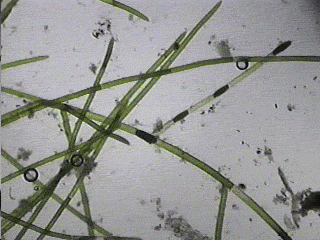
Many species exhibit long-term patterns in population abundance and distribution. For example, cutthroat trout suffer high mortality's during exceptionally warm weather. During summer, the temperature of water increases and the amount of dissolved oxygen decreases. Trout do not tolerate low levels of dissolved oxygen and many individual fish will die. The population of trout will slowly decrease over the summer.
Human Activities
Human activities also influence the size of different populations.
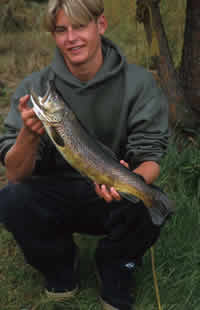
For example, over fishing will also reduce the population of trout in a river or salmon in the ocean.
Adding fertilizer to water systems provides additional nutrients for plankton. The result is an algae bloom. At first, you would think that having more algae would be good. More algae means more food and oxygen for aquatic animals. However, these organisms die and sink to the bottom of the lake or pond. As they decompose they use up valuable oxygen. The end result are low-levels of oxygen which can have a dramatic effect on other populations.
|
© 2002 Alberta Online Consortium
|
Lesson 10
Read pages 386 - 389
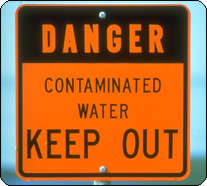 |
|
 |
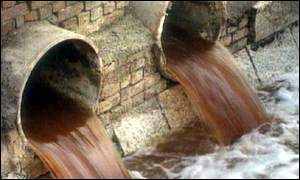
Determination and measurement of pollution may be made in the following ways:
(a) By direct chemical analysis of the water.
(b) By the use of "indicator" organisms. The population of indicator organisms which, by close observation and experience, increase or decrease depending on the type and degree of pollution. For example, blood worms thrive in low oxygen levels. Scientists infer low oxygen levels if a lake has a high population of blood worms.
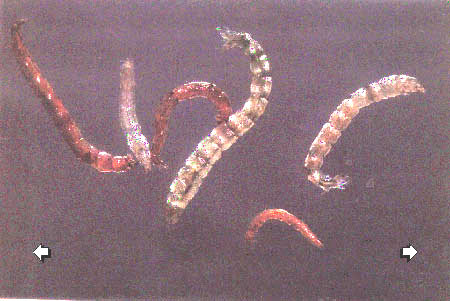
(c) Closely related to indicator species is the actual composition of the biological community. For example, a healthy pond may great biological diversity. That is, there is a variety of different species living the area. If the pond is polluted, the biological diversity of the ecosystem will decrease. That is, there will be fewer species living in the area. The remaining more tolerant species are usually experience a population explosion.
Healthy pond has great biological diversity which means:
- many species, but smaller population sizes of each species
- fewer species, but larger population sizes of these species
© 2002 Alberta Online Consortium
You have two options for your Section 3 Quiz - a multiple choice quiz or a written response quiz. You may choose to write the multiple choice or the written response. You only need to write one of them, so the choice is up to you! You are allowed to try both quizzes if you want, but it is not required.
The quiz attempt with the highest grade will be the one that is recorded on your report card.
The multiple choice quiz has 10 multiple choice, matching, and true/false questions. You have 15 minutes to complete it. As soon as the quiz submitted it will be auto-graded and you will receive a grade immediately.
Click the image above to start your quiz
The written response quiz has 5 short answer questions. Your responses must give a complete and detailed answer to the question. You have 20 minutes to complete the quiz. This quiz needs to be manually marked by your teacher, so you may have to wait a few days to get feedback and a grade.
Click the image above to start your quiz


